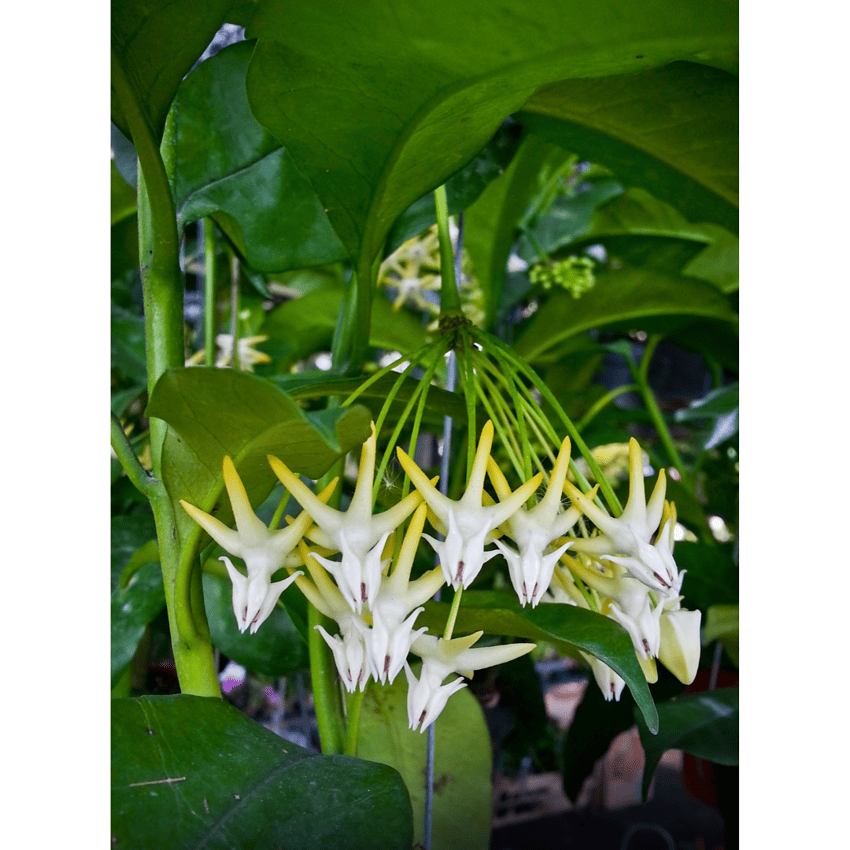Hoya multiflora, also known as the Shooting Star Hoya, is a beautiful and popular houseplant that belongs to the Apocynaceae family. This epiphytic plant is native to tropical Asia, where it usually grows on trees. Hoya multiflora is a freest-blooming Hoya species that produces large clusters of star-shaped flowers almost continuously all year round. It is an excellent choice for plant enthusiasts who want to add some color and life to their indoor space.
If you are considering adding a Hoya multiflora to your collection, there are a few things you should know. This plant is relatively easy to care for, making it an excellent choice for beginners. However, it does require some specific conditions to thrive. Hoya multiflora prefers bright, indirect light and well-draining soil. It is also sensitive to overwatering, so it is essential to let the soil dry out between waterings. With proper care, your Hoya multiflora will reward you with beautiful blooms and a touch of natural beauty in your home.
Overview
Hoya multiflora, commonly known as the Shooting Star Hoya, is a tropical plant species from the Apocynaceae family. Hoya multiflora is a popular houseplant due to its unique and beautiful flowers that resemble shooting stars.
Native to Southeast Asia, particularly Thailand, Malaysia, and Indonesia, Hoya Multiflora has gained popularity as a beloved houseplant worldwide.
This evergreen vine showcases a trailing growth habit with thick, waxy leaves that are typically lanceolate or elliptical in shape. The foliage appears glossy and showcases shades of green, providing an attractive backdrop for its exquisite blossoms. The flowers of Hoya Multiflora are the main highlight, forming clusters or umbels composed of numerous individual star-shaped blooms. The flowers emit a delightful fragrance, often described as sweet and reminiscent of jasmine, especially during the evening hours.
Beyond its ornamental appeal, is also known for its air-purifying qualities, helping to improve indoor air quality by removing pollutants. Additionally, it is generally resistant to most pests and diseases, adding to its overall low-maintenance nature.
Whether displayed as a stunning hanging plant or showcased on a shelf, Hoya Multiflora adds a touch of natural beauty and elegance to any interior space. Its exquisite flowers, ease of care, and versatility have made it a beloved choice for plant enthusiasts seeking a captivating addition to their botanical collection.
Description
The leaves of Hoya multiflora are deep green and waxy, with a thick and succulent texture. The unique and beautiful flowers of this plant are white and yellow, shaped like stars with five points. The flowers are small, measuring about 1 cm in diameter, but they are produced in large clusters that can cover the entire plant. The flowers have a sweet fragrance that is most noticeable at night.
Species
Hoya multiflora is part of the Hoya genus, which includes over 200 species of tropical plants. Hoya plants are known for their waxy leaves and unique flowers. They are popular houseplants due to their low maintenance and beautiful appearance.
Care
This plant is renowned for its ease of care, making it a favorite among both beginner and experienced plant enthusiasts. It thrives best in bright, indirect light, but it can also tolerate lower light conditions. Well-draining soil is essential for this plant, as it is susceptible to root rot if overwatered. Allowing the soil to dry out completely between waterings helps prevent moisture-related issues.
Hoya Multiflora is a tropical plant that appreciates warm temperatures and high humidity levels. It can be grown in hanging baskets, where its trailing vines cascade gracefully or trained to climb up a trellis or support. Pruning can be done to control its growth and encourage a fuller, bushier appearance.
Growing Tips
This is a climbing plant that can grow up to 3 feet tall. It can be grown in a variety of containers, including hanging baskets or trellises. It prefers high humidity, so misting the leaves regularly is a good idea. Fertilize the plant once a month during the growing season with a balanced fertilizer. Hoya multiflora can be propagated through stem cuttings or by layering.
Frequently Asked Questions
What is the ideal temperature for hoya multiflora?
It prefers warm temperatures between 60°F to 80°F (15°C to 27°C). It is important to avoid exposing the plant to temperatures below 50°F (10°C) for extended periods of time, as this can damage the plant.
How often should I water my hoya multiflora?
Your plant prefers to be kept slightly moist but not overly wet. Water the plant thoroughly when the top inch of soil is dry to the touch. It is important to avoid overwatering, as this can lead to root rot.
What type of soil is best for hoya multiflora?
The best soil for your plant is well-draining soil that is rich in organic matter. A mixture of peat moss, perlite, and vermiculite is a good choice. It is important to avoid using heavy soils that retain too much moisture.
Does hoya multiflora require direct sunlight?
No, it prefers bright, indirect light. It can tolerate some direct sunlight in the morning but should be protected from intense, direct sunlight in the afternoon.
How do I propagate hoya multiflora?
You can propagate through stem cuttings. Take a cutting at least 4 inches long with a few leaves. Dip the cut end in rooting hormone and plant it in a well-draining soil mixture. Keep the soil moist and the cutting in a warm, bright location until it develops roots.
What are common pests that affect hoya multiflora?
Common pests that can affect it include spider mites, mealybugs, and scale insects. Regularly inspect the plant for signs of infestation, such as yellowing leaves or a sticky residue on the leaves. Treat the plant with an appropriate insecticide or insecticidal soap if an infestation is detected.


